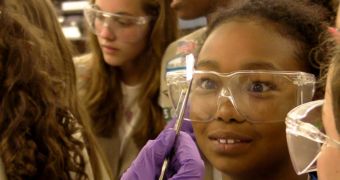A collaboration of researchers at the Rice University says that a recent investigation led to the creation of a new technique for producing the 2D carbon compound graphene. The method works so well that the material can be produced from any carbon source.
In order to prove this, the team created sheets of the nanomaterial from Girl Scout cookies. The sweets were selected mostly due to a dare that team members got from other experts at Rice, during an internal meeting where they presented their results.
Rice chemist James Tour accepted the challenge, and invited Houston Girl Scouts of America Troop 25080 to the Smalley Institute for Nanoscale Science and Technology at the university. The little girls were also asked to bring some cookies along.
The Rice team argues that it can obtain the precious compound from nearly anything that contains carbon, including food, insects and various forms of waste. Details of how the process works were published in the August 4 online issue of the esteemed journal ACS Nano.
“I said we could grow [graphene] from any carbon source – for example, a Girl Scout cookie, because Girl Scout Cookies were being served at the time. So one of the people in the room said, 'Yes, please do it. […] Let's see that happen',” Tour says of how the challenge was born.
The Rice team completed their presentation with a cost analysis. Graduate students Gedeng Ruan and Zhengzong Sun said that a 2 square inch sheet of graphene costs $250, and that a traditional box of Girls Scout cookies may produce the equivalent of 30 football fields of graphene.
A basic calculation showed that each box of cookies could produce a $15 billion profit. But, jokes aside, the team also made a serious point amid all the jokes. Graphene can now be extracted from nearly everything, just 7 years after it was first synthesized.
After the cookies were turned into graphene, researchers demonstrated the same process for chocolate, grass, polystyrene plastic and a cockroach's leg. The conversion process was enabled by a technique utilizing carbon deposition on copper foils.
The new study was funded by experts at the Sandia National Laboratory, the Air Force Office of Scientific Research and the Office of Naval Research MURI program. Tour says that the work is meant to enable the bulk manufacturing of graphene,
The compound has exquisite physical and chemical properties, and is touted as the replacement material for silicon in all electronic devices. But progress is stifled by the fact that the material is currently very expensive.
The Girl Scouts learned that “carbon – or any element – in one form can be inexpensive and in another form can be very expensive,” Tour concludes.

 14 DAY TRIAL //
14 DAY TRIAL //